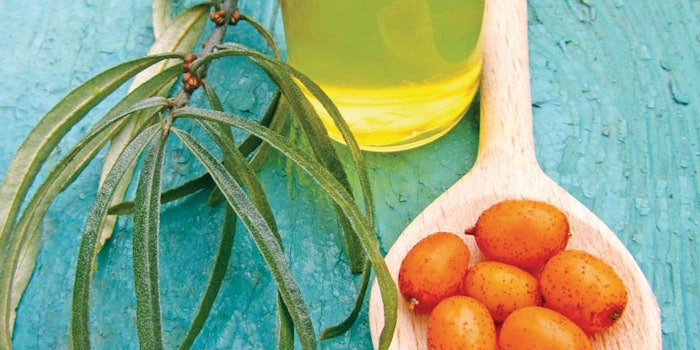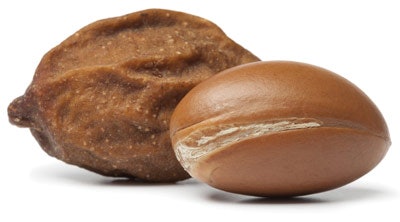
Plant oils have risen in the skin care ranks, not only as ingredients in treatment products but also as their own product category for massage or skin treatment. These oils can provide tremendous benefit, but not knowing which oils benefit which skin types can put an esthetician at risk.
Composition and the Skin Barrier
There is significant variability in plant oil composition, and some plant oils can cause problems for skin types with an impaired skin barrier. Plant oils consist of triglycerides and small amounts of free fatty acids.
Free fatty acids are known to disrupt skin barrier function. Oleic acid, an unsaturated fatty acid and a transdermal penetration enhancer, can disturb epidermal barrier function in children with eczema. Eczema is a chronic skin condition characterized by defects in the skin barrier function and impaired ability of the skin to hold water, causing decreased hydration. Detriment could be extended to all skin types with weak barrier function, in those who are genetically predisposed or those afflicted by external stressors.
Oleic and palmitoleic acids, present in plant oils such as olive and grape seed oils, have been shown to induce epidermal hyperplasia, clinically manifesting as scaly skin and abnormal follicular keratinization, implicated in acne.1 In the laboratory, molecular interactions between oleic acid and model stratum corneum lipids (consisting of ceramide, cholesterol and palmitic acid) has shown that lower concentrations of oleic acid preferentially mix with and disorder the ceramide-enriched domains. This is followed by perturbation of the palmitic acid-enriched domains and disruption of skin lipid domain separation at higher levels of oleic acid.2 Oleic acid increases water loss and substance penetration 24 hours after a single application in a dose-dependent manner, as shown clinical research by Johnson & Johnson. Oleic acid can permeate deep to the skin, reaching the dermal/epidermal junction. The affinity between plant oil components and skin lipids determines the extent of their penetration and clinically measurable effects on skin barrier function.3
Hydration: Sea Buckthorn
The use of any plant oil depends on its composition, the skin type, the targeted tissue and finally the concentration. Despite the presence of palmitoleic acid in sea buckthorn extract, this oil has been shown to have a positive effect on the skin condition of Asian healthy men. When applied as an emulsion over 84 days, the effects of sea buckthorn extract (5%) resulted in improvements in skin hydration and skin barrier function.4
Anti-aging: Camellia
If plant oils can penetrate, they can act not only as carriers of active ingredients but have anti-aging effects in their own right. Camellia japonica oil has been reported to have an anti-wrinkle potential determined by inducing type I pro-collagen synthesis and inhibiting the activity of matrix metalloproteinase in cell culture. Camellia oil also improved skin barrier function in Asian skin.5
Barrier Strength: Argan
 A recent review has deemed plant oils containing supplements beneficial for the skin barrier.6 Interestingly, a dual approach of daily consumption and/or application of argan oil has been tested in the challenged skin of postmenopausal women. In a 60 day period, both oral consumption and topical application of argan oil led to an improvement in skin barrier function and increased hydration in Morocco.7
A recent review has deemed plant oils containing supplements beneficial for the skin barrier.6 Interestingly, a dual approach of daily consumption and/or application of argan oil has been tested in the challenged skin of postmenopausal women. In a 60 day period, both oral consumption and topical application of argan oil led to an improvement in skin barrier function and increased hydration in Morocco.7Baby Softness: Coconut
The benefits of topical virgin coconut has been reported in Asian children with mild to moderate eczema by clinical improvement in the skin condition, reduction of TEWL and improved hydration (superior to that of mineral oil).8 However, there is data supporting the use of mineral oil to improve skin softness and barrier function better than other emollients, and it has been found favorable compared with many vegetable oils. Its physical effects on the skin translate into biological effects simply through its mechanism of hydrating and occluding the stratum corneum from which many benefits are derived.9
Mainstream academic research from the UK has shown that topical oils on immature baby skin may contribute to the development of childhood atopic eczema. Full-term newborn babies were randomly assigned to olive oil, sunflower oil or no oil, twice daily for 4 weeks, stratified by family history of atopic eczema. Babies treated with oils had significantly improved hydration but significantly less improvement in lipid lamellae structure. Therefore, until further research is conducted, caution should be exercised when recommending oils for neonatal skin.10 In Germany, the effect of sunflower seed oil on skin barrier development in premature infants has shown a delay in skin barrier maturation.11
Acne: Evening Primrose Oil
![In acne, abnormal keratinization of follicles is one of the first steps in comedone formation, which suggests an impaired skin barrier.12 Seasonal changes in acne treatments and skin care recommendations are important in the spa. Teenage boys, with and without acne, were monitored over the course of one year month by month. Sebum production [skin oiliness] was lowest in the winter and highest in the autumn. Skin barrier disruption was high across all seasons. Evidence for seasonality, with lower lipid production and reduced barrier function during the winter calls for a considerate approach when using plant oils topically in skin prone to acne.13](https://img.skininc.com/files/base/allured/all/image/2017/01/gci.SI1701_Oils_dream_43640891_primrose_400.png?auto=format%2Ccompress&fit=max&q=70&w=400) In acne, abnormal keratinization of follicles is one of the first steps in comedone formation, which suggests an impaired skin barrier.12 Seasonal changes in acne treatments and skin care recommendations are important in the spa. Teenage boys, with and without acne, were monitored over the course of one year month by month. Sebum production [skin oiliness] was lowest in the winter and highest in the autumn. Skin barrier disruption was high across all seasons. Evidence for seasonality, with lower lipid production and reduced barrier function during the winter calls for a considerate approach when using plant oils topically in skin prone to acne.13
In acne, abnormal keratinization of follicles is one of the first steps in comedone formation, which suggests an impaired skin barrier.12 Seasonal changes in acne treatments and skin care recommendations are important in the spa. Teenage boys, with and without acne, were monitored over the course of one year month by month. Sebum production [skin oiliness] was lowest in the winter and highest in the autumn. Skin barrier disruption was high across all seasons. Evidence for seasonality, with lower lipid production and reduced barrier function during the winter calls for a considerate approach when using plant oils topically in skin prone to acne.13Plant oils can, however, help the dryness of skin in acne treatment. Dermatologists experience an adverse effect of oral isotretinoin [acne drug] as inflammation and dryness of the upper lip skin [xerotic cheilitis]. Evening primrose oil has been suggested to benefit acne patients due to its role in improving skin hydration and barrier function in healthy skin and eczema. Asian volunteers, with moderate acne, received isotretinoin with or without oral capsules of evening primrose oil for eight weeks. Barrier function of the lip was disrupted during isotretinoin treatment, but oral oil application diminished the dryness. As the drug reduced acne lesions in both groups, the addition of oral evening primrose oil improved in acne patients being treated with oral isotretinoin.14
Follow the Research
Advances in research into the role plant oils can have in different skin types emphasizes the requirement for estheticians to follow new research, in order to understand the day-to-day and seasonal implications for their clientele.
REFERENCES
- www.cosmeticsandtoiletries.com/research/biology/199897981.html#sthash.3mD2vxC8.dpuf
- GL Mao et al, Oleic acid disorders stratum corneum lipids in Langmuir monolayers, Langmuir Apr 16 29(15) 4857-65 (2013)
- M Correa et al, Molecular interactions of plant oil components with stratum corneum lipids correlate with clinical measures of skin barrier function, Exp Dermatol Jan 23(1) 39-44 (2014)
- BA Khan and N Akhtar, Hippophae rhamnoides oil-in-water (O/W) emulsion improves barrier function in healthy human subjects, Pak J Pharm Sci, Nov 27(6) 1919-22 (2014)
- E Jung et al, Effect of Camellia japonica oil on human type I procollagen production and skin barrier function. J Ethnopharmacol, May 30 112(1) 127-31 (2007)
- www.cosmeticsandtoiletries.com/formulating/category/nutricosmetics/A-Great-Barrier-Enhanced-A-Review-of-Oral-PUFA-Supplements-for-Skin-390751311.html
- KQ Boucetta, Skin hydration in postmenopausal women: argan oil benefit with oral and/or topical use, Oct 13(5) 280–288 (2014)
- MT Evangelista, F Abad-Casintahan and L Lopez-Villafuerte, The effect of topical virgin coconut oil on SCORAD index, transepidermal water loss, and skin capacitance in mild to moderate pediatric atopic dermatitis: a randomized, double-blind, clinical trial, Int J Dermatol, Jan 53(1) 100-8 (2014)
- AV Rawlings and KJ Lombard, A review on the extensive skin benefits of mineral oil, Int J Cosmet Sci, Dec 34(6) 511-8 (2012)
- AL Cooke, Olive Oil, Sunflower Oil or no Oil for Baby Dry Skin or Massage: A Pilot, Assessor-blinded, Randomized Controlled Trial (the Oil in Baby SkincaRE [OBSeRvE] Study), Acta Derm Venereol, Mar 96(3) 323-30 (2016)
- V Kanti et al, Influence of sunflower seed oil on the skin barrier function of preterm infants: a randomized controlled trial, Dermatology, 229(3) 230-9 (2014)
- A Yamamoto, K Takenouchi and M Ito, Impaired water barrier function in acne vulgaris, Arch Dermatol Res, 287(2) 214-8 (1995)
- K Meyer et al, Evaluation of Seasonal Changes in Facial Skin With and Without Acne, J Drugs Dermatol Jun 14(6) 593-601 (2015)
- KY Park et al, The effect of evening primrose oil for the prevention of xerotic cheilitis in acne patients being treated with isotretinoin: a pilot study, Ann Dermatol, Dec 26(6) 706-12 (2014)










